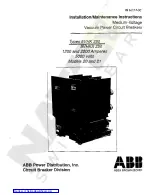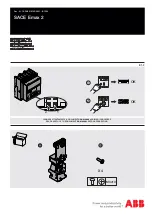
Page 18
I.B. 3A74792H08
Effective
09/2014
SECTION 4: INITIAL INSPECTION AND
INSTALLATION
4-1 INTRODUCTION
WARNING
BEFORE PLACING THE CIRCUIT BREAKER IN
SERVICE, CAREFULLY FOLLOW THE
INSTALLATION PROCEDURE GIVEN BELOW. NOT
FOLLOWING THE PROCEDURE CAN FAIL TO
UNCOVER SHIPPING DAMAGE THAT MAY RESULT
IN INCORRECT CIRCUIT BREAKER OPERATION
LEADING TO DEATH, BODILY INJURY, AND
EQUIPMENT DAM-AGE.
Before attempting to put a circuit breaker in service, it
should be carefully examined and operated manually and
electrically. In addition, carefully examine the breaker for
loose or obviously damaged parts. The following
information is a guide for performing recommended
checks and tests.
4-2 MANUAL OPERATION CHECK
Refer to Figures
3-8
and
4-1
and then proceed by placing
the maintenance tool into the manual charge socket
opening. Charge the closing springs with about 38 up
and down strokes of the handle. When charging is
complete the closing crank goes over center with an
audible
CLICK
and the springs Charged/Discharged
indicator shows “Charged.”
NOTICE
If the springs are to be charged on a closed circuit
breaker, no click is heard at the end of charging
operation. Discontinue charging and remove the
maintenance tool as soon as “Charged” flag is fully
visible. Continued attempts to charge further may
result in damage to the mechanism.
Remove the maintenance tool. Close and trip the circuit
breaker. Repeat several times.
4-3 VACUUM INTERRUPTER INTEGRITY
Using a dry, lint free cloth or paper towel, clean all the
accessible insulating surfaces of the pole units. Conduct a
vacuum interrupter integrity check as described in
Section 6.
4-4 INSULATION
Check the circuit breaker’s primary and secondary
insulation as described in Section 6.
4-5 CONTACT EROSION AND WIPE
Manually charge the closing springs and close the
circuit breaker. Check contact erosion and wipe as
described in Section 6.
4-6 PRIMARY CIRCUIT RESISTANCE
Check the primary circuit resistance as described in
Section 6. The resistance should not exceed the
values specified. Record the values obtained for
future reference.
4-7 NAMEPLATE
Compare the circuit breaker nameplate information
with switchgear drawings for compatibility.
4-8 ELECTRICAL OPERATION CHECK
After having completed all previous checks and tests,
the circuit breaker is ready to be operated electrically.
It is preferred that this check be made with the circuit
Figure 4-1 Type VCP-W Circuit Breaker Manual
Charging Handle in Use
Summary of Contents for 380 VCP-W 21
Page 2: ......
Page 13: ...I B 3A74792H08 Page 7 Effective 09 2014 ...
Page 22: ...Page 16 I B 3A74792H08 Effective 09 2014 Figure 3 7 Typical VCP W 38kV Escutcheon ...
Page 23: ...I B 3A74792H08 Page 17 Effective 09 2014 Figure 3 8 Typical VCP W 38kV Escutcheon ...
Page 33: ...I B 3A74792H08 Page 27 Effective 09 2014 compartment Figure 5 5 Charging Schematic ...
Page 38: ...Page 32 I B 3A74792H08 Effective 09 2014 Figure 5 10 Undervoltage Trip Device Configuration ...
Page 60: ...Page 54 I B 3A74792H08 Effective 09 2014 ...
Page 62: ...Page 56 I B 3A74792H08 Effective 09 2014 Style 3A74792H08 Printed in USA ...














































